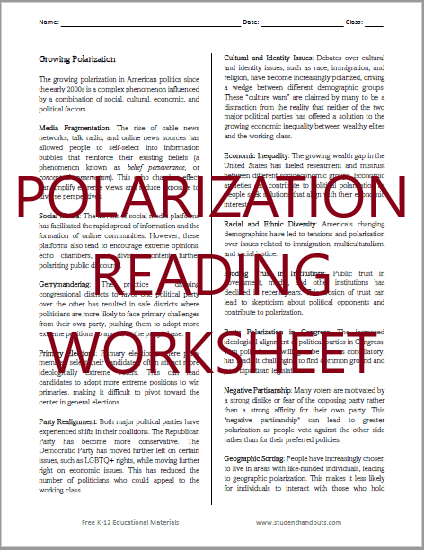| Growing Polarization Reading with Questions |
|---|
| www.studenthandouts.com ↣ U.S. History ↣ Polarization ↣ Polarization Worksheets |
|
Click here to print. Answers will vary.
Base your answers to the following questions on the text and your knowledge of social studies. 1. How do people’s interactions feed their conceptual conservatism? 2. How have the two major political parties changed in recent years? 3. Describe the so-called "culture wars." 4. Why might distrust in institutions cause increased polarization? 5. Imagine that you are a political advisor to a presidential candidate. What policies would you encourage this person to adopt? Why? |
 |
    |
|
The growing polarization in American politics since the early 2000s is a complex phenomenon influenced by a combination of social, cultural, economic, and political factors.
Media Fragmentation: The rise of cable news networks, talk radio, and online news sources has allowed people to self-select into information bubbles that reinforce their existing beliefs (a phenomenon known as belief perseverance, or conceptual conservatism). This echo chamber effect can amplify extreme views and reduce exposure to diverse perspectives. Social Media: The advent of social media platforms has facilitated the rapid spread of information and the formation of online communities. However, these platforms also tend to encourage extreme opinions, echo chambers, and divisive content, further polarizing public discourse. Gerrymandering: The practice of drawing congressional districts to favor one political party over the other has resulted in safe districts where politicians are more likely to face primary challenges from their own party, pushing them to adopt more extreme positions to appeal to the party's base. Primary Elections: Primary elections, where party members select their candidates, often attract more ideologically extreme voters. This can lead candidates to adopt more extreme positions to win primaries, making it difficult to pivot toward the center in general elections. Party Realignment: Both major political parties have experienced shifts in their coalitions. The Republican Party has become more conservative. The Democratic Party has moved further left on certain issues, such as LGBTQ+ rights, while moving further right on economic issues. This has reduced the number of politicians who could appeal to the working class. Cultural and Identity Issues: Debates over cultural and identity issues, such as race, immigration, and religion, have become increasingly polarized, driving a wedge between different demographic groups. These “culture wars” are claimed by many to be a distraction from the reality that neither of the two major political parties has offered a solution to the growing economic inequality between wealthy elites and the working class. Economic Inequality: The growing wealth gap in the United States has fueled resentment and mistrust between different socioeconomic groups. Economic anxieties can contribute to political polarization as people seek solutions that align with their economic interests. Racial and Ethnic Diversity: America's changing demographics have led to tensions and polarization over issues related to immigration, multiculturalism, and racial justice. Eroding Trust in Institutions: Public trust in government, media, and other institutions has declined in recent years. This erosion of trust can lead to skepticism about political opponents and contribute to polarization. Party Polarization in Congress: The increased ideological alignment of political parties in Congress, with politicians unwilling to be seen as conciliatory, has made it challenging to find common ground and pass bipartisan legislation. Negative Partisanship: Many voters are motivated by a strong dislike or fear of the opposing party rather than a strong affinity for their own party. This "negative partisanship" can lead to greater polarization as people vote against the other side rather than for their preferred policies. Geographic Sorting: People have increasingly chosen to live in areas with like-minded individuals, leading to geographic polarization. This makes it less likely for individuals to interact with those who hold different political views. These factors, among others, have contributed to the growing polarization in American politics. Polarization can hinder constructive debate, compromise, and problem-solving, making it more challenging to address the complex issues facing the nation. Addressing this polarization may require a combination of structural reforms, efforts to bridge divides, and changes in political culture and behavior. |
| www.studenthandouts.com ↣ U.S. History ↣ Polarization ↣ Polarization Worksheets |








